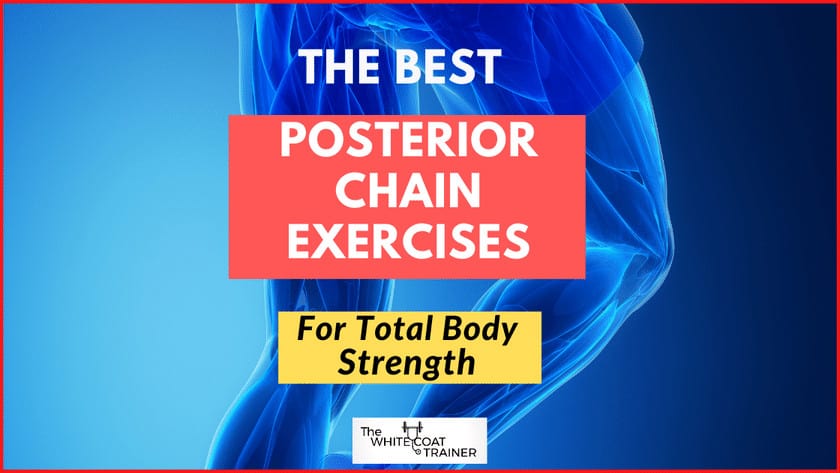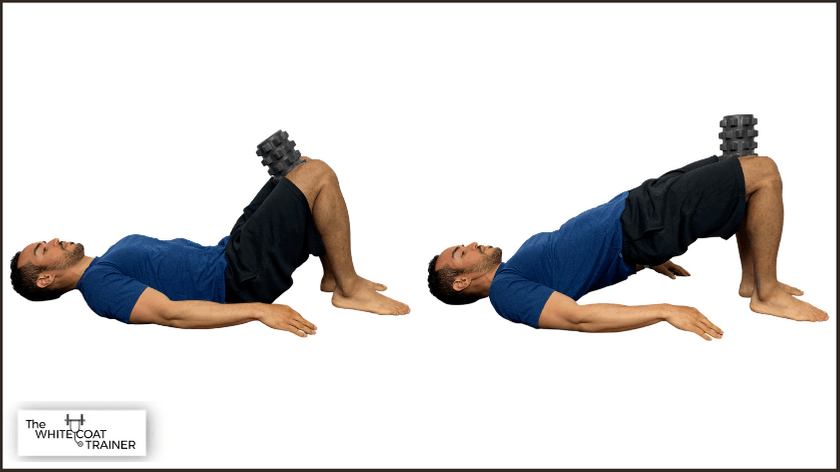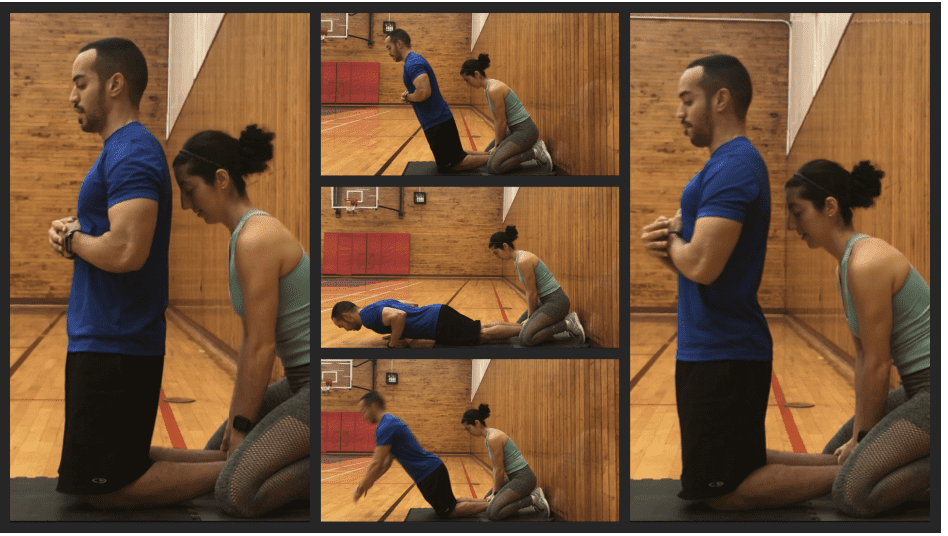This post goes over the best posterior chain exercises of all time.
The posterior chain comprises the glutes, hamstrings, lower back muscles, and spinal erectors.
After reading this post, you will learn
- the best posterior chain exercises to target each muscle group,
- how to execute them correctly,
- and why a strong posterior chain matters for core and posture strength.
Let’s get started.

Quick Overview
- The posterior chain is responsible for providing stability and strength to your spine. These muscles assist in keeping you upright and balanced during your daily activities.
- This chain of muscles can quickly become weak and underdeveloped if you are not performing the right exercises.
- Common exercises for strengthening the posterior chain include hip hinge movements like the deadlift, good morning, and hip thrust.
What Exercises Target The Posterior Chain?
Posterior chain exercises are any movement that engages the muscles of your glutes, hamstrings, lower back, and spinal erectors.
These include compound exercises like deadlifts, squats, and bent-over rows, as well as isolation movements like hamstring curls, glute bridges, and pull-throughs.
The one thing that all of these exercises have in common is that they are all hip hinge movements.
Let’s go over them in more detail.
The Best Lower Body Posterior Chain Exercises
Good morning
Good mornings are one of my favorite exercises for targeting the entire posterior chain in one go. This movement involves hinging forward at the hips and lowering your torso toward the ground without bending your knees.
This exercise is best with a barbell on your back, but you can also do it with lighter weights such as kettlebells or dumbbells.
Use caution when doing this exercise, as it can put a lot of strain on the lower back if you do it incorrectly.
*Placing the bar in your hands instead of your upper back turns this into a Romanian Deadlift.
Deadlift
The main traditional exercise for working your posterior chain is the deadlift.
This exercise targets all the major muscle groups of the back, such as the latissimus dorsi, erector spinae, and glutes.
In addition, since it requires lifting a heavy weight from the ground, deadlifts help you develop power, which is critical for sports performance and day-to-day activities.
Proper form is crucial when performing a deadlift, especially when using a barbell. If you cannot keep your lumbar spine in a neutral position, you should use a lighter weight or switch to a kettlebell version of the exercise.
Hip Dominant Squat
Squats are one of the best exercises to strengthen your posterior chain, particularly your glutes and lower back muscles.
The key is to perform a hip-dominant back squat. In other words, your hips should move back like sitting in a chair while keeping your knees behind your toes.
You will also need a slightly wider than shoulder-width stance.
Begin with a manageable weight before progressing to heavier loads and increasing difficulty. Keep your feet flat on the floor, your chest up, and your spine neutral while descending.
Hip Thrust
One lesser-known posterior chain exercise is the hip thrust. Hip thrusts use a barbell across your hips from a seated position (with your upper back resting on a bench or box). The goal is to lift the barbell towards the ceiling using explosive power from your glutes.
Studies show that hip extension exercises like hip thrusts are the best way to activate the gluteus maximus and hamstrings.
There are other variations besides the barbell hip thrust, such as
- bodyweight versions,
- banded,
- dumbbell,
As always, starting with a light load is ideal as you get comfortable with the movement.
Pull Through
Pull throughs are a great exercise that targets the glutes and hamstrings while also engaging the core muscles.
To do this exercise, you will need a band or a cable machine that you can anchor to a low surface. Then you will grab the cable/band between your legs and face away from it.
Next, hinge forward at your hips while maintaining a straight back. This movement is similar to a Romanian deadlift.
Control this exercise to really emphasize tension in the hamstrings.
Kettlebell Swing
Kettlebell swings are a great way to increase explosiveness and power in the hips while training the posterior chain muscles.
Stand with your feet slightly wider than shoulder-width, holding a kettlebell in your outstretched hands with an overhand grip.
The swing should start with the kettlebell between your legs as you hinge your hips. From this position, drive your hips forward, squeezing your glutes at the top of the movement to propel the kettlebell forward.
You must use controlled momentum to reduce the risk of injury.
45 Degree Back Raises
The back raise is a fantastic exercise to include in your posterior chain workouts.
It does require the use of a 45-degree back extension bench, but most gyms have one of these available.
To perform the back raise, anchor yourself on the bench with your feet secured and your abs tight.
Then, engage your core and lower your torso toward the floor without changing your spinal alignment. At the bottom, you should feel a stretch in your hamstrings and calves.
Pause at the bottom and then lift your torso back up to the starting position, squeezing your glutes at the top.
Hip Dominant Unilateral Exercises
Unilateral leg exercises are another great way to target and strengthen the posterior chain muscles. These single leg exercises train one side of the body at a time, challenging the core stabilizers and glute region.
Examples include:
- Lunges (using a wider step where your knee doesn’t pass your toes)
- Step-ups (using a variation in which your knee doesn’t pass your toes)
- Split squats (wide stance)
- Hip hinges, (such as single-leg Romanian deadlifts)
These exercises also add an additional challenge of balance and stability when compared to their bilateral counterparts.
Honorable Mentions
Here are a few other effective exercises for developing posterior chain strength that didn’t make the top of the list.
Why?
Because you need special equipment to do them, and the vast majority of people don’t have access to this equipment.
*P.S. I go over all the best lower body exercises to build strong legs (including quads, adductors, and abductors) here.
Bonus: The Bent Over Row
Okay, this last one isn’t a lower body exercise, but hear me out.
The bent-over row is an upper body exercise that targets the arms as well as the latissimus dorsi (lats), rhomboids, posterior deltoids, and trapezius muscles of the back.
However, due to the bent over position of the exercise, it also works the muscles of the posterior chain.
You can do the bent-over row with a barbell or with dumbbells.
When lifting the barbell, retract your shoulder blades to engage all the posterior muscles.
Also, be sure to keep your lower back and neck neutral to avoid excessive strain on the lower back.
Why Is It Important To Develop This Muscle Group?
Working the posterior chain is vital to physical fitness and overall strength. Developing this group of muscles provides many benefits, including
- improved posture,
- enhanced athletic performance,
- improved stability,
- and injury prevention (especially if you have an overly dominant anterior chain).
Most people have a weak posterior chain due to lifestyle habits and improper training.
How Do You Know If You Have A Weak Posterior Chain?
Identifying if you have a weak posterior chain can be tricky; however, several clues can help.
The most common signs include:
- noticing your lower back fatiguing quickly during physical activity
- low back pain
- obvious muscle imbalances
- constantly injuring the front side of your body
- bad posture
- struggling to develop sufficient power output when running or with explosive movements like jumping.
If you have a weak backside, create a program in which you do twice as many reps for your posterior chain exercises as you do for the front side.
Are There Any Bodyweight Versions I Can Do At Home?
Glute Bridges
Glute Bridges are a great way to activate the muscles of the posterior chain at home. The nice thing about this movement is that you can modify it to increase the difficulty to match your skill level.
Lie flat on your back with your feet on the floor and outside your hips. Next, flatten your lower back on the ground to posteriorly tilt your pelvis.
Once in position, drive through your heels to lift your hips off the floor into a bridge. Maintain a straight line from your knees to shoulders throughout this exercise.
Really focus on engaging your glutes as you lift. Squeeze at the top before slowly lowering yourself down to finish one rep.
You can increase the difficulty of this exercise by elevating your feet or using one leg at a time.
Remember to focus on proper form first and increase the difficulty as you get stronger.

Sliding Leg Curls
Sliding leg curls are another great way to target your hamstrings and glutes from the comfort of your own home.
To perform this exercise, you will need two towels or gliders to place underneath your feet. Lie on your back with your feet hip width on the towel/gliders. Next, lift into a bridge and hold this position throughout the exercise.
To do the leg curl, slide your feet back towards your glutes and contract your hamstring muscle. Pause at the top before slowly returning to starting position.
Keep your hips elevated for the entire movement, and use a controlled tempo.
Alternatively, you can also perform this exercise with a bosu ball.

Nordic Hamstring Curl
The Nordic hamstring curl is one of the best exercises to target the hamstrings and glutes.
It is an advanced exercise, so make sure you have mastered the sliding leg curl before attempting it.
To perform this exercise, start in a kneeling position with your feet anchored behind you. (You can use a couch or have someone hold them in place).
Once you are in position, lean forward and lower your body until your hands touch the floor. Depending on your strength level, you can use your hands to push back up to return to starting position.
Remember to keep your core tight throughout the entire movement and use a controlled tempo for the best results.

Commonly Asked Questions
What muscle groups do posterior chain exercises target?
Posterior chain exercises target the muscles located along the backside of your lower body. These include the glutes, hamstrings, spinal erectors, and core muscles. Strengthening these muscles helps improve posture, reduce lower back pain and injury risk, and enhance athletic performance.
Are there specific exercises that can help with back pain?
Lower back pain can often result from muscular imbalances in the muscles attached to the pelvis. Strengthening the glutes, hamstrings, spinal erectors, and core muscles can help to reduce the pressure in your lower back and promote good posture.
Start with exercises such as glute bridges, sliding leg curls, and 45-degree back raises. In addition, you should also train core stability with exercises like planks, side planks, and hollow body holds.
Conclusion
Strengthening the posterior chain muscles is critical to unlocking improved performance and preventing injuries. Whether you are a beginner or an elite athlete, you can find movement patterns to challenge the back of your body.
Now I want to hear from you.
Is the backside of your body much weaker than the front side?
What exercises are you most excited to add to your workout?
Share your thoughts in the comments section below.
Now, go forth and develop a strong posterior chain!

Alex Robles, MD, CPT / Brittany Robles, MD, MPH, CPT
Alex & Brittany Robles are physicians, NASM Certified Personal Trainers, and founders of The White Coat Trainer: a resource dedicated to improving the health and fitness of busy professionals using time-efficient strategies. Their advice has been featured in My Fitness Pal, Prevention, Livestrong, Reader’s Digest, Bustle, The Active Times, and more. Learn more about them here.
